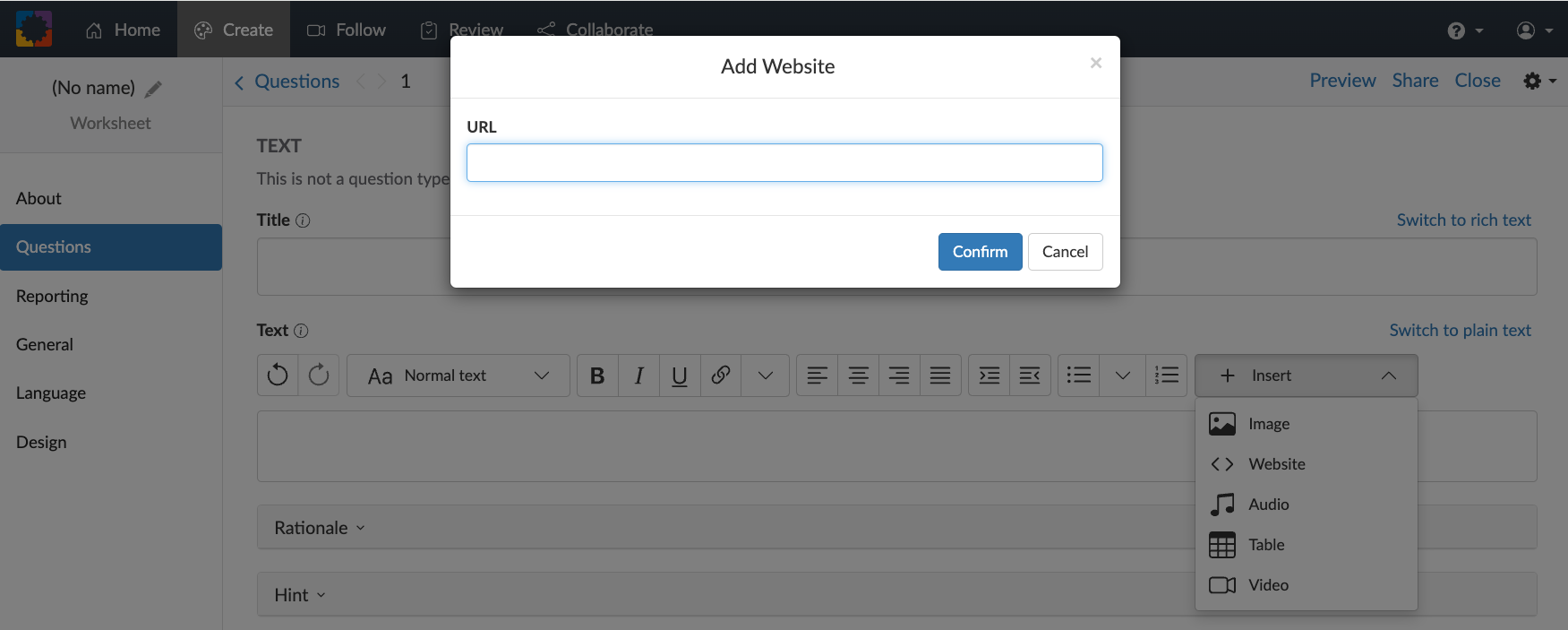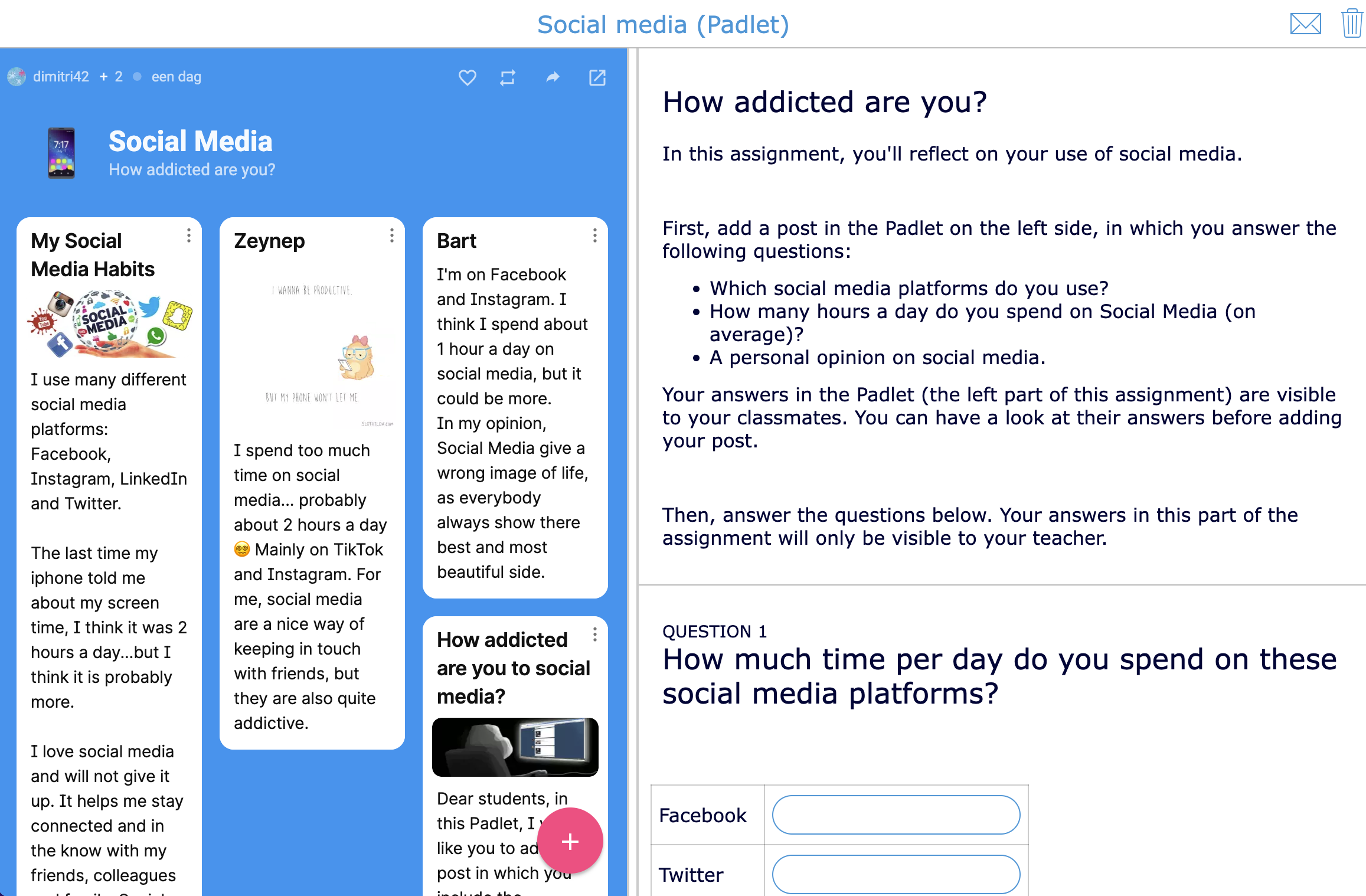5 Reasons to App Smash Padlet with BookWidgets
 Kate Baker —
Kate Baker —
Blending the interactive capabilities of BookWidgets with the collaborative nature of Padlet empowers educators to design engaging, student-centered learning experiences. Whether embedding BookWidgets activities in a Padlet board or integrating Padlet within a BookWidgets lesson, this app smash fosters creativity, participation, and deeper engagement.
We’ll explore five key reasons to app smash BookWidgets with Padlet, along with step-by-step instructions for seamless integration and practical examples of how these two tools work together.
In this post, we will cover...
- What is BookWidgets?
- What is Padlet?
- Why should we appsmash BookWidgets and Padlet?
- How do we appsmash BookWidgets and Padlet?
- How to embed a Padlet in BookWidgets?
- How to embed BookWidgets in Padlet?

What is BookWidgets?
If you are new to BookWidgets, BookWidgets is an all-in-one platform designed to support the entire learning process, allowing teachers to create interactive activities and evaluate their students' understanding. With 40+ widget types, including quizzes, games, hotspot images, and WebQuests, BookWidgets enhances engagement and streamlines assessment. Teachers can incorporate 36 question types—30 of which are auto-scored—into the Quiz, Video Quiz, Worksheet, and Split Worksheet widgets to create customized, curriculum-aligned activities.
If you're new to BookWidgets, start by checking out our Getting Started with BookWidgets blog post to help you get up and running quickly.
Used by educators worldwide, BookWidgets streamlines both formative and summative assessments, organizing student responses in the reporting dashboard for efficient review, scoring, and feedback. Integrated with Google Classroom, Microsoft Teams, Moodle, Canvas --& more!--teachers can use "Live Widgets" to keep an eye on their student's progress in real-time and provide instant support.
Interested in purchasing BookWidgets without committing to a full-year subscription or waiting for the next budget cycle? Learn more about our special, limited-time pricing for groups of teachers. And get started today by creating a free BookWidgets account. You can find all of the ready-to-use widgets featured in this post in this folder in the BookWidgets Blog group.

What is Padlet?
Padlet is a versatile digital bulletin board that allows users to post and organize content collaboratively. Educators and students can add text, images, videos, links, and even drawings, making it a highly flexible tool for brainstorming, reflection, collaboration, and resource sharing. With various layout options—such as grid, wall, map, and timeline—Padlet provides a dynamic way to structure learning activities.
💡Wondering how you can use Padlet in your classes? Check out this blog post: 30+ ways to use Padlet for teachers and students

Why should we appsmash BookWidgets and Padlet?
App smashing is the process of combining multiple digital tools to enhance learning experiences, allowing educators to leverage the strengths of each tool for more engaging, interactive, and efficient instruction.
🤔 Curious to learn more about app smashing? Check out this blog post, "App smashing: Combine these 20+ educational tools to level up your classroom".
While both Padlet and BookWidgets offer unique strengths, combining them together unlocks new possibilities for interactive and collaborative learning.

5 Reasons to App-Smash BookWidgets and Padlet
Independence and collaboration are not mutually exclusive; when combined, they create a more holistic learning experience. Students benefit from the freedom to explore and reflect on their own, while also engaging with the ideas and feedback of their peers. This blend fosters deeper understanding, critical thinking, and a sense of community within the learning process.
Here are 5 reasons to app-smash Padlet with BookWidgets:
1. Increased Student Collaboration
BookWidgets excels at structured, interactive activities, where students submit responses to their teacher, while Padlet enhances real-time, student-to-student, and class interaction and collaboration.
Example 1: Students collaborate in groups to write creative stories on a Padlet, using prompts revealed through this Randomness widget. Each group spins the wheels to reveal the genre, setting, character, and plot with one person in the group starting to write the story based on the elements given randomly. One after another, members of the group continue the story by posting on the Padlet in their group's column. This can be a fun, quick-write challenge within a class period or an extended, multi-day creative writing project. Students can use reactions and add comments on the Padlet to provide feedback and additional ideas.
Example 2: Remember the board game Clue? We have a digital version of the game Clue where students work as a team to navigate through a BookWidgets WebQuest widget, trying to solve a mystery. To help the students organize the clues and make connections, I've embedded a Padlet Sandbox for them to use as their dectective notebook.
2. Engaging Choice Board Experience
Using the Planner and WebQuest widgets, teachers can create interactive choice boards that contain both individual and collaborative activities. BookWidgets Planner and WebQuest widgets help structure the independent learning effectively, while Padlet offers a way for students to choose how to show what they know with their classmates.
Example: In this choice board made with a Planner widget, elementary students can choose from the teacher-created list of independent activities made with BookWidgets and collaborative activities in Padlet to show what they know about shapes. Students click on the plus icon to access the list, select which activities to complete, and check the box for each when done.
3. Seamless Peer Review & Feedback
BookWidgets supports structured student work submission, and Padlet can complement this by enabling open peer feedback with multimedia options. Students post their completed BookWidgets assignments on a Padlet for classmates to comment, like, and provide constructive feedback.
Example: In this Worksheet widget created by my colleague Julia, students interact with the multimedia resources to practice and learn the pronounciation of difficult words and different phonemes by recording audio of themselves speaking. After listening to their own recording and correcting any mistakes, students go to the Padlet and record audio for their classmates to hear. This process scaffolds the review and feedback process by allowing students to first self-evaluate before allowing their peers to review and offer additional feedback. The Worksheet widget also holds students accountable for documenting their peer review.
4. Interactive Portfolios and Showcases
BookWidgets allows students to complete and track individual progress, while Padlet provides a live, evolving space to showcase students work collectively over time. Students can posts their BookWidgets submissions in a Padlet for review and reflection. Students can use the reactions and comments in Padlet to laude their classmates' work. The embedded Padlet can be used as both for inspiration at the start of a project and as a display space for completed projects, as shown in the following two examples. The Padlet can be shared with colleagues, parents, and the greater school community for a digital gallery space.
Example 1: A Padlet featuring already-created inspirational graphics is embedded in a Split Whiteboard and serves as inspiration for students to create their own inspirational graphic.
Example 2: Similar to the previous example but with additional questions to guide the creative provess, students are tasked with applying graphic design concepts to create an inspirational image in this Split Worksheet widget. Students complete the project steps as they answer questions then share their inspirational images to a class Padlet.
5. Whole-Class Brainstorming & Online Discussions
BookWidgets offers structured brainstorming tools and question-types for showing the teacher what students know, and Padlet expands this by enabling real-time, whole-class collaboration and discussion.
Example 1: After individually brainstorming using a Mind Map widget, students continue the process on a Padlet board. In this example, students individually brainstorm responses to both sides of a debate, answering the question "Does pineapple belong on pizza?". Then they take a stance and continue discussing the issue with their classmates on the Padlet.
Example 2: In this hyperdoc style lesson I created, students interact with the multimedia resources in this Worksheet widget to learn about and reflect on the heorism, leadership, and legacy of September 11, 2001. Students watch various embedded YouTube videos, explore a virtual timeline of events from the 9/11 Memorial & Museum, take a virtual field trip via the embedded Image Carousel widget, answer reflective questions, and post to a community Padlet that features responses from students from around the United States.
Example 3: In this BookWidgets Split worksheet, created by my colleague Dimitri, students answer reflective questions about their social media usage then engage in an online conversation with their classmates by posting to the embedded Padlet board.

How do we app smash Padlet and BookWidgets?
Teachers can embed a Padlet board in widget activities or link to widget activities in Padlet, choosing the best method based on their instructional goals, student collaboration needs, and where Padlet fits into the learning cycle.
- Embedding a Padlet in BookWidgets is ideal when teachers want students to interact within a structured activity, but still contribute to a shared space—such as brainstorming ideas before completing an individual task or sharing their completed work. When sharing the widget activity through an LMS, teachers can follow student progress via Live Mode.
- Linking a BookWidgets activity in Padlet, however, works best when Padlet serves as an interactive hub for ongoing collaboration, allowing students to build on each other’s ideas over time or showcase their learning collectively. Padlet is also good for curating multiple, auto-scored widget activities that do not require student submissions. Please note that when linking widget activities within Padlet, the widgets will not have a connection to your LMS, so you will not be able to use Live Mode.
The decision to embed Padlet in BookWidgets or link BookWidgets in Padlet depends on whether students are demonstrating understanding in an individual space to the teacher (BookWidgets) or a collaborative group setting with the class (Padlet), and whether the learning activity is being used as a starting point, midpoint, or reflection tool in the learning process.

How to embed a Padlet in BookWidgets?
With just a few quick clicks, you can embed any Padlet in BookWidgets using the rich text editor and share the widget activity via a link, QR code, or LMS integration. All you need is the link to the Padlet!
Step 1: Open a Worksheet, Split Worksheet, Quiz, Video Quiz, or Split Whiteboard widget in Editor View

Step 2: Add a Question or Go to the Text tab in a Split Worksheet or Split Whiteboard

Step 3: Access the Rich Text Editor and click on Insert, < > Website

Step 4: Enter in the Padlet's URL

Step 5: Click on the 3 dots menu in the corner of the embedded Padlet

Step 6: Click on Edit and Adjust Height and Width (if needed)


How to embed BookWidgets in Padlet?
While you aren't able to embed a widget in a Padlet using iframes, you can link to widgets and add the links to the posts within a specific padlet. The cover image of the widget will appear in the Padlet post. Please note that when sharing widgets within Padlet, the widgets will not have a connection to your LMS. We recommend linking widgets that are auto-scored and do not require students submission.
💡Pro Tip: If you create a unique cover image for your widget, this image rather than the widget icon, will be shown as the thumbnail in Padlet.
Step 1: Open a Padlet and Click on the + icon

Step 2: Type in Text and Click on Link Icon

Step 3: Paste in the Student Link to a Widget

Step 4: Hit Publish

Step 5: Click on the 3 Dots Icon and Pin the Post (if needed)

Wrap Up
By combining Padlet’s collaborative features with BookWidgets’ interactive learning activities, educators can create dynamic, student-centered experiences. Whether embedding a Padlet in a BookWidgets WebQuest or linking BookWidgets activities inside a Padlet, this app smash enhances engagement, fosters collaboration, and provides new ways to interact with content and have students show what they know.
Want to learn more about creating engaging lesson activities with BookWidgets?
✔️ If you're new to BookWidgets, start by checking out our Getting Started with BookWidgets blog post to help you get up and running quickly.
✔️ Sign up for upcoming free webinars and view recordings on the BookWidgets Teacher Academy Page.
✔️ Learn more about our special, limited-time pricing for groups of teachers for purchasing BookWidgets now without having to wait for the next school year or budget cycle.
✔️ Follow BookWidgets on BlueSky and LinkedIn and join our teacher community on Facebook!
✔️ And, be sure to connect with me, too, on BlueSky, Facebook, and LinkedIn!












